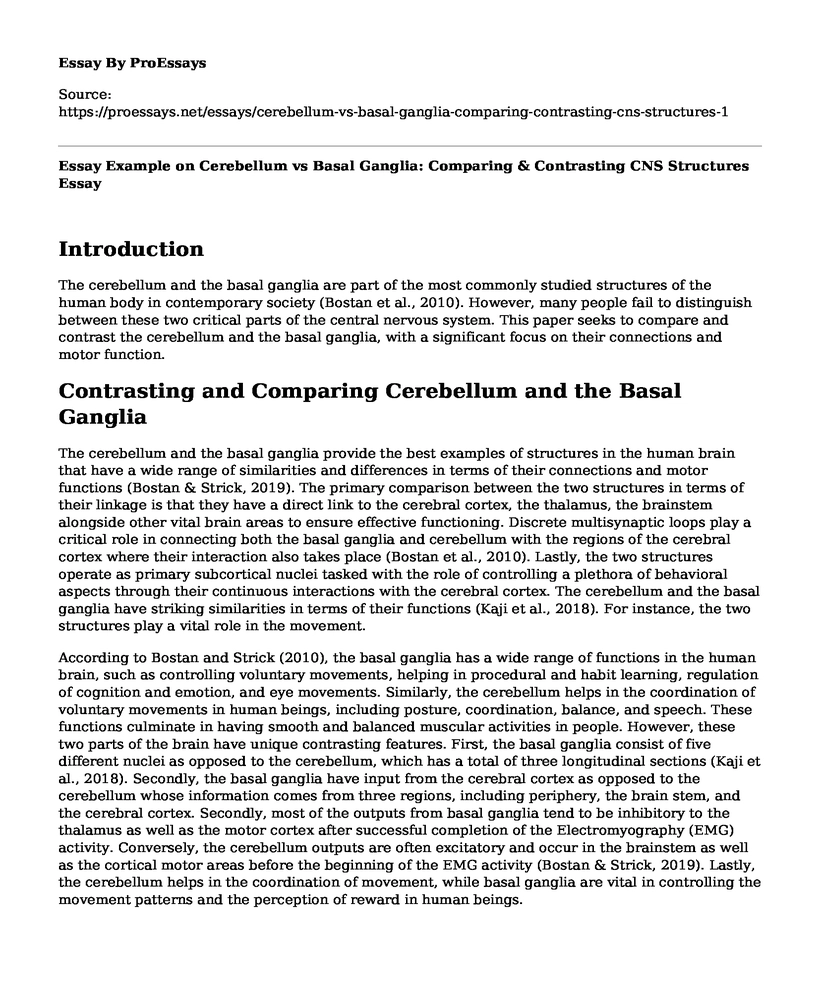Introduction
The cerebellum and the basal ganglia are part of the most commonly studied structures of the human body in contemporary society (Bostan et al., 2010). However, many people fail to distinguish between these two critical parts of the central nervous system. This paper seeks to compare and contrast the cerebellum and the basal ganglia, with a significant focus on their connections and motor function.
Contrasting and Comparing Cerebellum and the Basal Ganglia
The cerebellum and the basal ganglia provide the best examples of structures in the human brain that have a wide range of similarities and differences in terms of their connections and motor functions (Bostan & Strick, 2019). The primary comparison between the two structures in terms of their linkage is that they have a direct link to the cerebral cortex, the thalamus, the brainstem alongside other vital brain areas to ensure effective functioning. Discrete multisynaptic loops play a critical role in connecting both the basal ganglia and cerebellum with the regions of the cerebral cortex where their interaction also takes place (Bostan et al., 2010). Lastly, the two structures operate as primary subcortical nuclei tasked with the role of controlling a plethora of behavioral aspects through their continuous interactions with the cerebral cortex. The cerebellum and the basal ganglia have striking similarities in terms of their functions (Kaji et al., 2018). For instance, the two structures play a vital role in the movement.
According to Bostan and Strick (2010), the basal ganglia has a wide range of functions in the human brain, such as controlling voluntary movements, helping in procedural and habit learning, regulation of cognition and emotion, and eye movements. Similarly, the cerebellum helps in the coordination of voluntary movements in human beings, including posture, coordination, balance, and speech. These functions culminate in having smooth and balanced muscular activities in people. However, these two parts of the brain have unique contrasting features. First, the basal ganglia consist of five different nuclei as opposed to the cerebellum, which has a total of three longitudinal sections (Kaji et al., 2018). Secondly, the basal ganglia have input from the cerebral cortex as opposed to the cerebellum whose information comes from three regions, including periphery, the brain stem, and the cerebral cortex. Secondly, most of the outputs from basal ganglia tend to be inhibitory to the thalamus as well as the motor cortex after successful completion of the Electromyography (EMG) activity. Conversely, the cerebellum outputs are often excitatory and occur in the brainstem as well as the cortical motor areas before the beginning of the EMG activity (Bostan & Strick, 2019). Lastly, the cerebellum helps in the coordination of movement, while basal ganglia are vital in controlling the movement patterns and the perception of reward in human beings.
Conclusion
The cerebellum and the basal ganglia have a wide range of features that contract and compare them. The cerebellum plays a vital role in the reception of information from the sensory systems, the spinal cord, and other areas of the brain and regulates all types of motor movement. Basal ganglia, on the other hand, refer to a combination of different structures connected to the thalamus part of the brain involved in the coordination of movement. Understanding these differences is crucial in achieving healthy living, as discussed in this paper.
References
Bostan, A. C. & Strick, P. L. (2010). The cerebellum and basal ganglia are interconnected. Neuropsychology Review, 20(3), 261-270. https://www.ncbi.nlm.nih.gov/pmc/articles/PMC3325093/.
Bostan, A. C. & Strick, P. L. (2019). The basal ganglia and the cerebellum: Nodes in an integrated network. Nature Reviews Neuroscience, 19(6), 338-350. https://www.ncbi.nlm.nih.gov/pmc/articles/PMC6503669/.
Bostan, A. C., Dum, R. P., & Strick, P. L. (2010).The basal ganglia communicate with the cerebellum. Proceedings of the National Academy of Sciences of the United States of America (PNAS), 107 (18) 8452-8456. https://www.pnas.org/content/107/18/8452.
Kaji, R., Bhatia, K., & Graybiel, A. M. (2018). Pathogenesis of dystonia: Is it of cerebellar or basal ganglia origin? Journal of Neurology, Neurosurgery, & Psychiatry, 89(5), 488-492. https://jnnp.bmj.com/content/89/5/488.
Cite this page
Essay Example on Cerebellum vs Basal Ganglia: Comparing & Contrasting CNS Structures. (2023, Jun 06). Retrieved from https://proessays.net/essays/cerebellum-vs-basal-ganglia-comparing-contrasting-cns-structures-1
If you are the original author of this essay and no longer wish to have it published on the ProEssays website, please click below to request its removal:
- Essay Sample on Rights of Animals
- Human Long Bone, Compact and Spongy Bone Paper Example
- Research Paper on Methods for Treating Muscle Tissue Loss
- How Climate Contributed to the Endangered Species Issue
- Relationship Between Man and Nature Essay Example
- Exploring The Wonders of the Ocean - Essay Sample
- Four Main Tissues - Essay Sample







